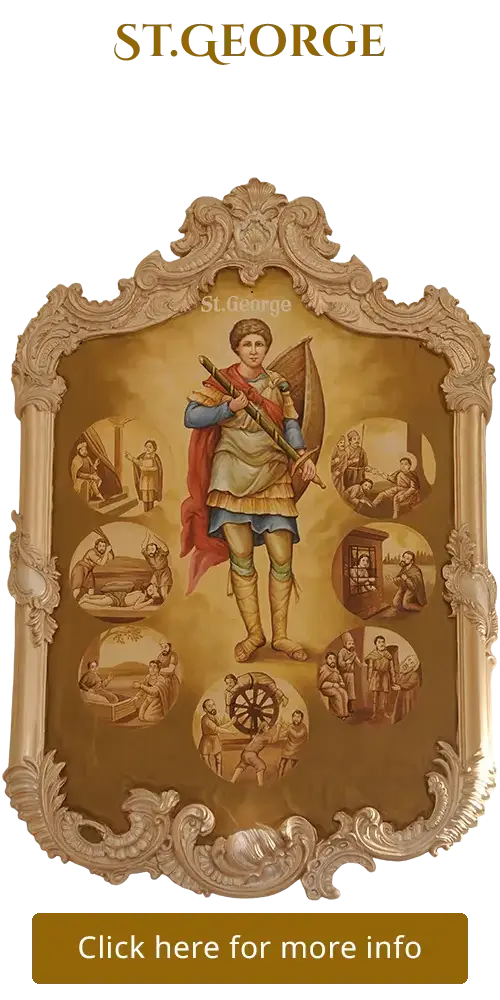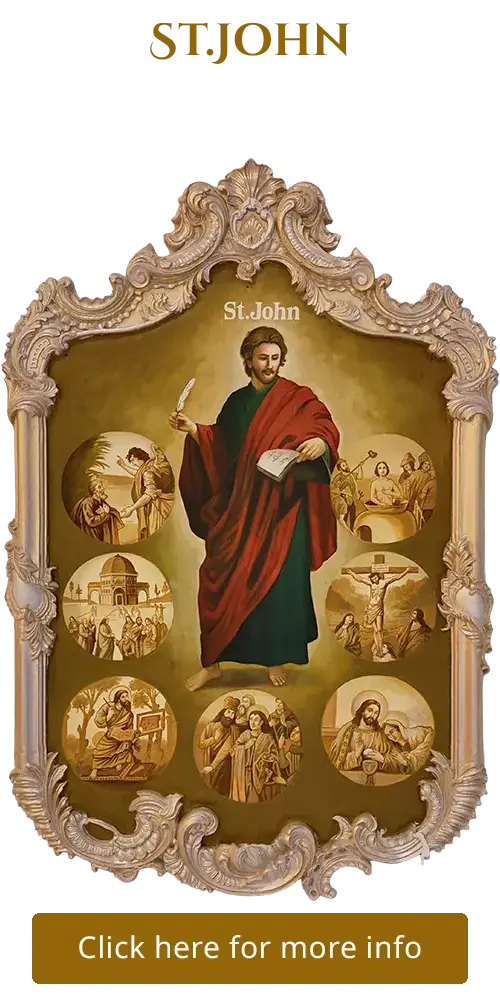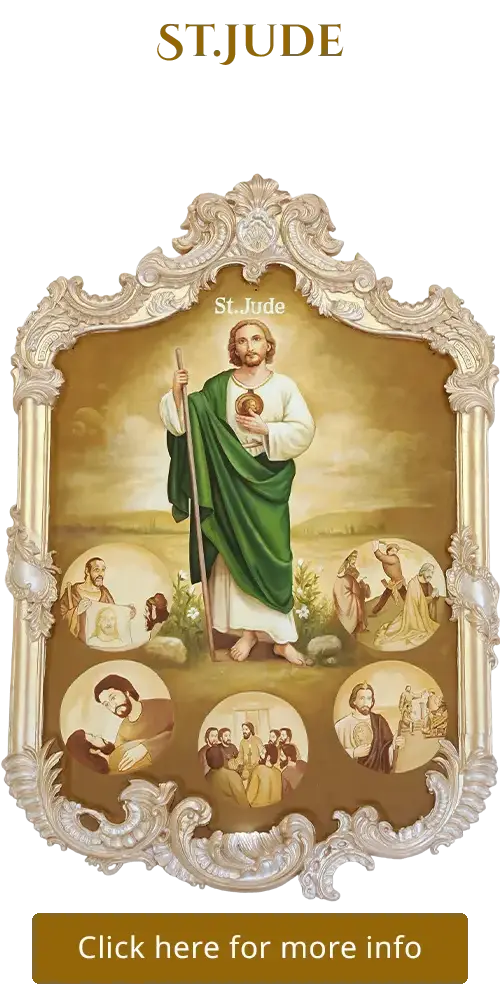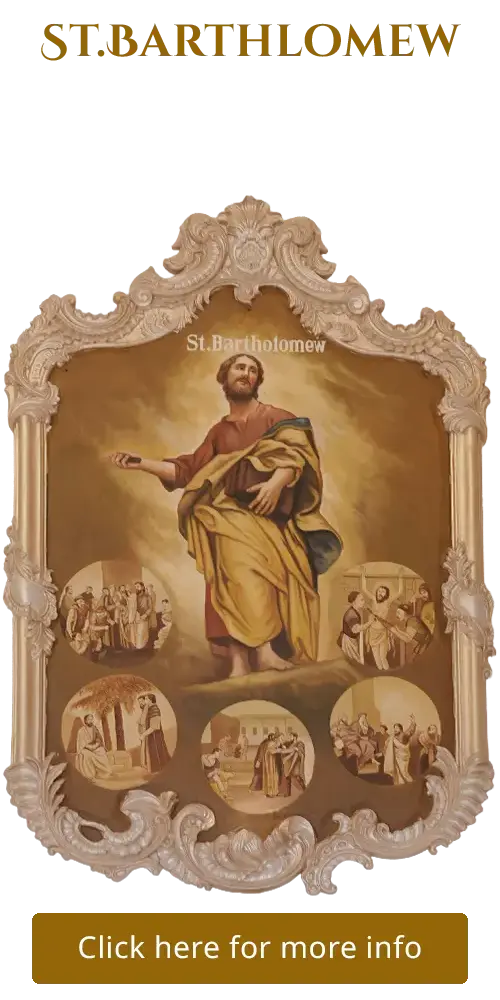St. Peter
Inside Paintings - South Wall
St. Peter
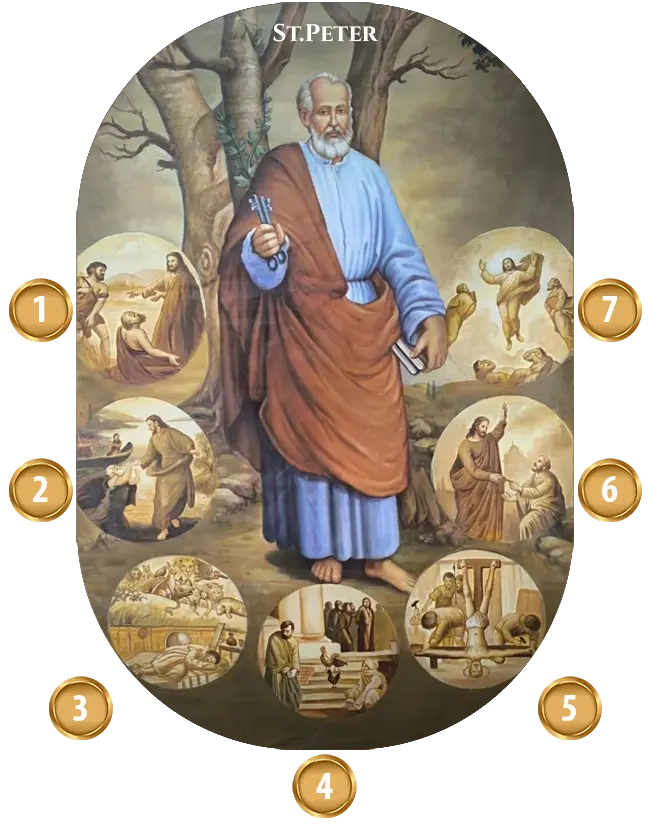


1. Call to Discipleship
Biblical Reference: Luke 5:8
Description: Peter, originally named Simon, has fallen to his knees and is looking away in shame. Christ is walking towards Peter. This is a lakeside scene.
Jesus had instructed Peter and his partners to cast their nets again after a fruitless night of fishing. The resulting catch was so immense that their nets began to break, and they had to call for help from another boat, which also became overloaded.
Seeing the miraculous catch, Peter is struck with a profound sense of his own unworthiness. He recognizes Jesus’ divine authority and power, and his sinful nature is brought into sharp relief.
Peter falls at Jesus’ knees and cries out, “Go away from me, Lord, for I am a sinful man!”, This moment marks the beginning of Peter’s discipleship. It highlights the humility and self-awareness that Jesus seeks in his followers, as Peter recognizes his need for a savior.
Jesus tells Peter not to be afraid and that he will now be a “fisher of men”. The men then leave their boats and follow Jesus.
2. Peter Walks on Water
Biblical Reference: Matthew 14:22-33
Description: Peter, originally named Simon, was a fisherman by profession. Jesus called him and his brother Andrew to follow Him, saying, “Follow me, and I will make you fishers of men.” They immediately left their nets and followed Jesus.
3. Peter’s Vision and the Conversion of Cornelius
Historical Reference: Tradition & Early Christain writings.
Description: Peter was in Joppa, staying with Simon the tanner, and had a vision while praying. He saw a large sheet descending from heaven, filled with various animals, both clean and unclean according to Jewish law. A voice commanded him to “kill and eat,” and when Peter protested that he had never eaten anything unclean, the voice responded, “What God has cleansed, no longer consider unholy”. This vision challenged Peter’s understanding of Jewish dietary laws and expanded his view of who could be included in God’s kingdom.
Cornelius, a Roman centurion in Caesarea, was a devout man who feared God and prayed regularly. An angel appeared to him in a vision and instructed him to send for Peter in Joppa. The angel told Cornelius that his prayers and charitable deeds had come up as a memorial before God.
Despite his initial hesitation, Peter, guided by the Holy Spirit, went to Cornelius’s house. Peter shared the message of Jesus with Cornelius and his household. While Peter was speaking, the Holy Spirit fell on all who heard the word, including Cornelius and his household, demonstrating God’s acceptance of Gentiles into the Christian faith. Cornelius and his household were baptized, marking the first time Gentiles were brought into the Christian community without first becoming Jewish.
The conversion of Cornelius demonstrated that God does not show favoritism and accepts all who fear him and do what is right, regardless of their background.
4. The Denial of Peter
Biblical Reference: Gospel of Matthew 26:33–35, the Gospel of Mark 14:29–31, the Gospel of Luke 22:33–34 and the Gospel of John 13:36–38.
Description: Peter replied, “Even if all fall away on account of you, I never will.” “I tell you the truth,” Jesus answered, “This very night, before the rooster crows, you will disown me three times.” But Peter declared, “Even if I have to die with you, I will never disown you.” And all the other disciples said the same.
Later that night, Jesus was arrested. Then they seized him and led him away, bringing him into the high priest’s house. Peter followed at a distance and when they had kindled a fire in the middle of the courtyard and had sat down together, Peter sat down with them. A servant girl saw him seated there in the firelight. She looked closely at him and said, “This man was with him.” Panic stricken, he denied it. “Woman, I don’t know him,” he said.
When the servant girl saw him there, she said again to those standing around, “This fellow is one of them.” Again he denied it.
After a little while, those standing there went up to Peter and said, “Surely you are one of them, for your accent gives you away.” Then he began to call down curses on himself and he swore to them, “I don’t know the man!” Immediately a rooster crowed. Then Peter remembered the word Jesus had spoken: “Before the rooster crows, you will disown me three times.” And he went outside and wept bitterly. This final incident is known as the Repentance of Peter.
5. Martyrdom of St. Peter
Historical Reference: Church tradition and early Christian writings.
Description: Accounts from Clement of Rome and Eusebius, the Acts of Peter
In the epilogue of the Gospel of John, Jesus is presented as hinting at Peter’s death: “But when you grow old, you will stretch out your hands, and someone else will fasten a belt around you and take you where you do not wish to go.” This is interpreted by some as a reference to Peter’s crucifixion.
A major fire broke out in Rome in July 64 AD, destroying a large portion of the city. Nero, the Roman Emperor, needed a scapegoat for the devastation and chose to blame the Christians, a relatively new and often misunderstood religious group. This led to a period of intense persecution, during which many Christians, including Saint Peter, were arrested and executed. According to tradition, Peter was crucified upside down at his own request, as he did not believe he was worthy to die in the same manner as Jesus. Peter was buried in a cemetery near the Circus of Nero, where St. Peter’s Basilica now stands.
6. The Delivery of the Keys
Historical Reference: Matthew 16:18-19
Description: Jesus hands the keys to the kingdom of heaven to Saint Peter saying, “You are Peter, the Rock; and on this rock I will build my church… I will give you the keys of the kingdom of Heaven.” Saint Peter was made the first pope, which justified the supremacy of the pope being the spiritual power of the early Church.
It is painted in the Sistine Chapel of the Apostolic Palace in Vatican City, the official residence of the pope. The keys of heaven or keys of Saint Peter are seen as a symbol of papal authority and are seen on papal coats of arms (those of individual popes) and those of the Holy See and Vatican City State.
7. The Transfiguration of Jesus
Biblical Reference: Matthew 17:1-9, 2 Peter 1:16-21.
Description: The Transfiguration of Jesus is a pivotal event where Jesus’s appearance changed, revealing his divine glory to his disciples Peter, James, and John. During this event, which took place on a mountain, Jesus’s face shone like the sun, and his clothes became dazzling white. Moses and Elijah also appeared, symbolizing the Law and the Prophets, and a voice from a cloud declared Jesus as God’s beloved Son. St. Peter, along with James and John, witnessed this event, and Peter’s reaction is recorded in the Gospels.
Peter, overwhelmed by the experience, suggested building three shelters (tabernacles) for Jesus, Moses, and Elijah. When a cloud overshadowed them and a voice proclaimed Jesus as the Son of God, Peter and the others were afraid.
The event was meant to strengthen the faith of the disciples, particularly Peter, James, and John, as they prepared to follow Jesus on his path to Jerusalem.

